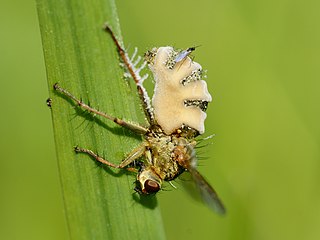Related Research Articles

Beauveria bassiana is a fungus that grows naturally in soils throughout the world and acts as a parasite on various arthropod species, causing white muscardine disease; it thus belongs to the group of entomopathogenic fungi. It is used as a biological insecticide to control a number of pests, including termites, thrips, whiteflies, aphids and various beetles. Its use in the control of bed bugs and malaria-transmitting mosquitos is under investigation.
An entomopathogenic fungus is a fungus that can kill or seriously disable insects. They do not need to enter an insect's body through oral ingestion or intake; rather, they directly penetrate though the exoskeleton.

Orgyia leucostigma, the white-marked tussock moth, is a moth in the family Erebidae. The species was first described by James Edward Smith in 1797. The caterpillar is very common especially in late summer in eastern North America, extending as far west as Texas, California, and Alberta.

Beauveria is a genus of asexually-reproducing fungi allied with the ascomycete family Cordycipitaceae. Its several species are typically insect pathogens. The sexual states (teleomorphs) of Beauveria species, where known, are species of Cordyceps.
Raymond J. St. Leger is an American mycologist, entomologist, molecular biologist and biotechnologist who currently holds the rank of Distinguished University Professor in the Department of Entomology at the University of Maryland, College Park.

Entomophthora is a fungal genus in the family Entomophthoraceae. Species in this genus are parasitic on flies and other two-winged insects. The genus was circumscribed by German physician Johann Baptist Georg Wolfgang Fresenius (1808–1866) in 1856.

Entomophthora muscae is a species of pathogenic fungus in the order Entomophthorales which causes a fatal disease in flies. It can cause epizootic outbreaks of disease in houseflies and has been investigated as a potential biological control agent.

Entomophaga maimaiga is a Japanese fungus which has shown striking success in managing spongy moth populations in North America.

Muscardine is a disease of insects. It is caused by many species of entomopathogenic fungus. Many muscardines are known for affecting silkworms. Muscardine may also be called calcino.

Entomophaga is a genus of entomopathogenic fungi in the Entomophthoraceae family and also the order Entomophthorales. This has been supported by molecular phylogenetic analysis.

Pandora is a genus of fungi within the order Entomophthorales. This has been supported by molecular phylogenetic analysis.
Zoophthora is a genus of fungi in the family Entomophthoraceae. Like other taxa in this family, Zoophthora species cause disease in insects and as such are considered entomopathogenic fungi.

The spotted lanternfly is a planthopper indigenous to parts of China and Vietnam. It has spread invasively to Japan, South Korea, and the United States, where it is often referred to by the acronym "SLF". Its preferred host is the 'tree of heaven', but it also feeds on other trees, and on crops including soybean, grapes, stone fruits, and Malusspp. In its native habitat, L. delicatula populations are regulated by parasitic wasps.
Entomophaga grylli is a fungal pathogen which infects and kills grasshoppers. It is the causal agent of one of the most widespread diseases affecting grasshoppers. This is sometimes known as summit disease because infected insects climb to the upper part of a plant and grip the tip of the stem as they die; this ensures widespread dispersal of the fungal spores. The fungus is a species complex with several different pathotypes, each one of which seems to be host-specific to different subfamilies of grasshoppers. The pathogen is being investigated for its possible use in biological pest control of grasshoppers.
Donald W. Roberts was an American insect pathologist and one of the originators of that field. He was especially known for research into biological pest control of Lepidoptera by Metarhizium but also Beauveria bassiana. He was a Research Professor Emeritus in the Biology Department of Utah State University.
Batkoa major is a naturally occurring fungus that infects insects.
Tarichium is a genus of fungi within the order Entomophthorales of the Zygomycota. This has been supported by molecular phylogenetic analysis.

Furia is a genus of fungi within the family of Entomophthoraceae. This has been supported by molecular phylogenetic analysis.
Batkoa is a genus of fungi within the family of Entomophthoraceae and order Entomophthorales of the Zygomycota. This has been supported by molecular phylogenetic analysis.
Eryniopsis is a genus of fungi within the family of Entomophthoraceae and order Entomophthorales. This has been supported by molecular phylogenetic analysis.
References
- ↑ "Ann Hajek | Department of Entomology". entomology.cals.cornell.edu. Retrieved October 6, 2019.
- 1 2 3 4 5 6 "Dr. Ann Hajek, ESA Fellow (2018)". Entomological Society of America. Retrieved September 8, 2019.
- ↑ Ann E. Hajek (1999). "Pathology and Epizootiology of Entomophaga maimaiga Infections in Forest Lepidoptera". Microbiology and Molecular Biology Reviews . 63 (4): 814–835. doi:10.1128/MMBR.63.4.814-835.1999. PMC 98977 . PMID 10585966.
- ↑ Eric H. Clifton; Louela A. Castrillo; Andrii Gryganskyi; Ann E. Hajek (2019). "A pair of native fungal pathogens drives decline of a new invasive herbivore". Proceedings of the National Academy of Sciences. 116 (9): 9178–9180. Bibcode:2019PNAS..116.9178C. doi: 10.1073/pnas.1903579116 . PMC 6511058 . PMID 31010927.
- ↑ Ann E. Hajek (June 29, 2013). Ecology of Terrestrial Fungal Entomopathogens. pp. 193–249. ISBN 978-1-4757-9074-0.
{{cite book}}:|journal=ignored (help) - ↑ Bernard Papierok; Ann E. Hajek (1997). "Chapter V-2 - Fungi: Entomophthorales". In Lawrence A. Lacey (ed.). Manual of Techniques in Insect Pathology. Biological Techniques. pp. 187–212. doi:10.1016/B978-0-12-432555-5.X5000-3. ISBN 978-0-12-432555-5.
- ↑ E. Wajnberg; John K. Scott; Paul C. Quimby, eds. (2001). "Chapter 5: Evaluating Non-target Effects of Pathogens Used for Management of Arthropods". Evaluating Indirect Ecological Effects of Biological Control. p. 81. ISBN 978-0-85199-453-6.